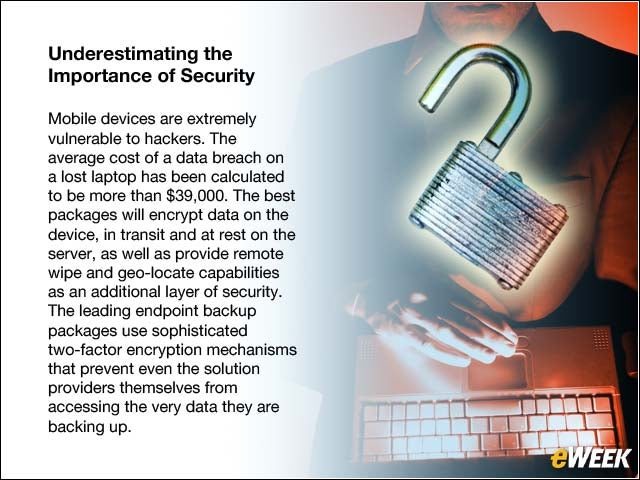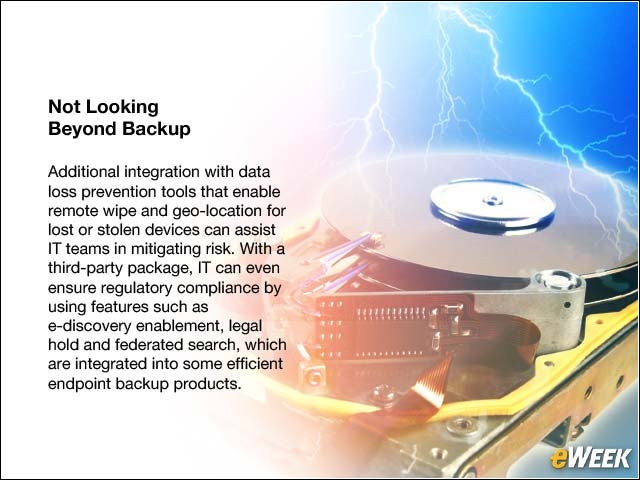eWEEK content and product recommendations are editorially independent. We may make money when you click on links to our partners. Learn More.
2Backing Up Only Desktops and Servers
According to recent studies, an impressive 28 percent of all corporate data is stored exclusively on laptops, smartphones and tablets. The modern workforce is increasingly mobile, so companies that rely solely on desktop backup put more than a quarter of their enterprise data at risk. Only about 35 percent of laptops are backed up, which means a large majority of corporate laptops are vulnerable to data loss.
3Using Legacy Server Backup Software Repurposed for Devices
Software such as this only works in highly predictive environments where devices are backed up on a schedule and over a secure high-bandwidth connection. When these legacy server backup systems are repurposed for endpoint backup, they lose effectiveness. Faster, nonintrusive backups, the ability to work over networks without a VPN and flexible, opportunistic scheduling are absolutely critical features for endpoint backup.
4Believing All Deduplication Products Are Created Equal
Device-created data is growing exponentially, and bandwidth speeds are not increasing enough to deal with the influx of data. In order to deal with this large gap, companies should look for packages with deduplication technology. These packages eliminate data duplication across all users within the enterprise—duplications that can account for up to 80 percent of an organization’s data.
5Forgetting About the User Experience
When the backup process is intrusive, employees tend to skip necessary backup sessions. An effective backup package must include bandwidth and CPU throttling capabilities and WAN optimization to provide end users with a nonintrusive user experience. Backup packages that are unobtrusive ensure that users will not meddle with or disengage the software as it backs up all of their valuable data.
6Underestimating the Important of Security
Mobile devices are extremely vulnerable to hackers. The average cost of a data breach on a lost laptop has been calculated to be more than $39,000. The best packages will encrypt data on the device, in transit and at rest on the server, as well as provide remote wipe and geo-locate capabilities as an additional layer of security. The leading endpoint backup packages use sophisticated two-factor encryption mechanisms that prevent even the solution providers themselves from accessing the very data they are backing up.
7Thinking Short Term and Limited Scalability
Companies should find a solution that provides scalable storage and the ability to support a geographically distributed organization. Growth is never easy to predict perfectly, and a company that does not use a scalable package risks stagnation or huge costs to upgrade their backup service plan. When a plan is fully scalable and geographically flexible, companies can rest easy knowing that they have predictable budgets and no surprise costs.
8Not Selecting the Right Deployment Model
The decision to go with a cloud or on-premises deployment should be based on business factors such as budget, timeline, corporate policies and external compliance regulations. Companies that do not consider these factors risk getting pigeon-holed into a package that does not align with the organization’s IT strategy. Cloud-based solutions offer on-demand scalability and allow shifting of capital expenses to operating expenses. On-premises packages may provide higher performance along with cost advantages from hosting infrastructure behind a corporate firewall.
9Not Understanding the Total Cost of Ownership
There are more than merely upfront costs to consider when finding an endpoint data backup package. There is also the opportunity cost of the initial setup time, hardware costs, deployment time and cost of resources to manage the package into the future. If a product boasts of low upfront costs to entice business, it may require weeks of initial setup time and effort. Also, packages that do not support mass client deployment impact both IT and end-user productivity severely, again increasing the total cost of ownership.
10Not Preparing for Bring Your Own Device (BYOD)
BYOD allows employees to maximize their productivity and must be taken into consideration despite the numerous challenges it poses in keeping corporate data secure. A worthwhile solution will provide users with mobile apps to access their data while still limiting access to corporate data on BYOD devices.
11Not Looking Beyond Backup
Additional integration with data loss prevention tools that enable remote wipe and geo-location for lost or stolen devices can assist IT teams in mitigating risk. With a third-party package, IT can even ensure regulatory compliance by using features such as e-discovery enablement, legal hold and federated search, which are integrated into some efficient endpoint backup products.










